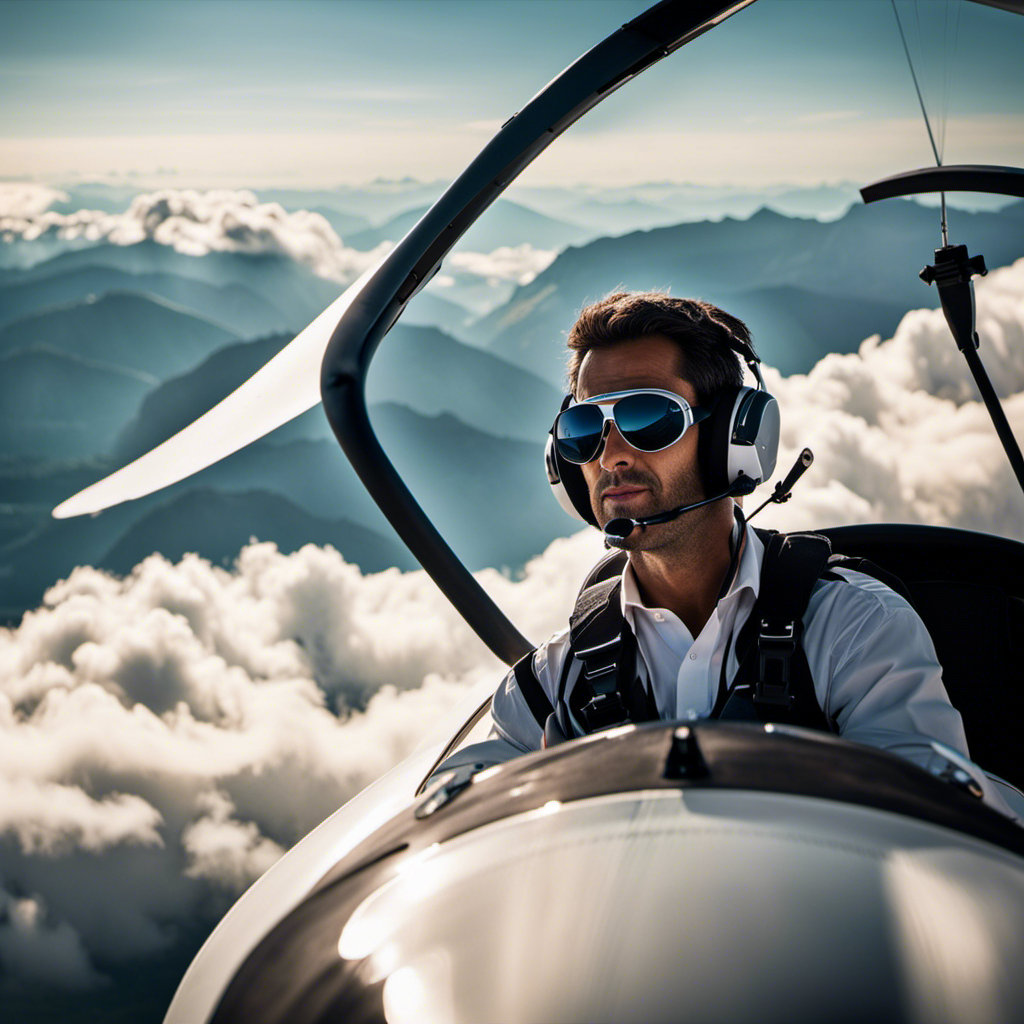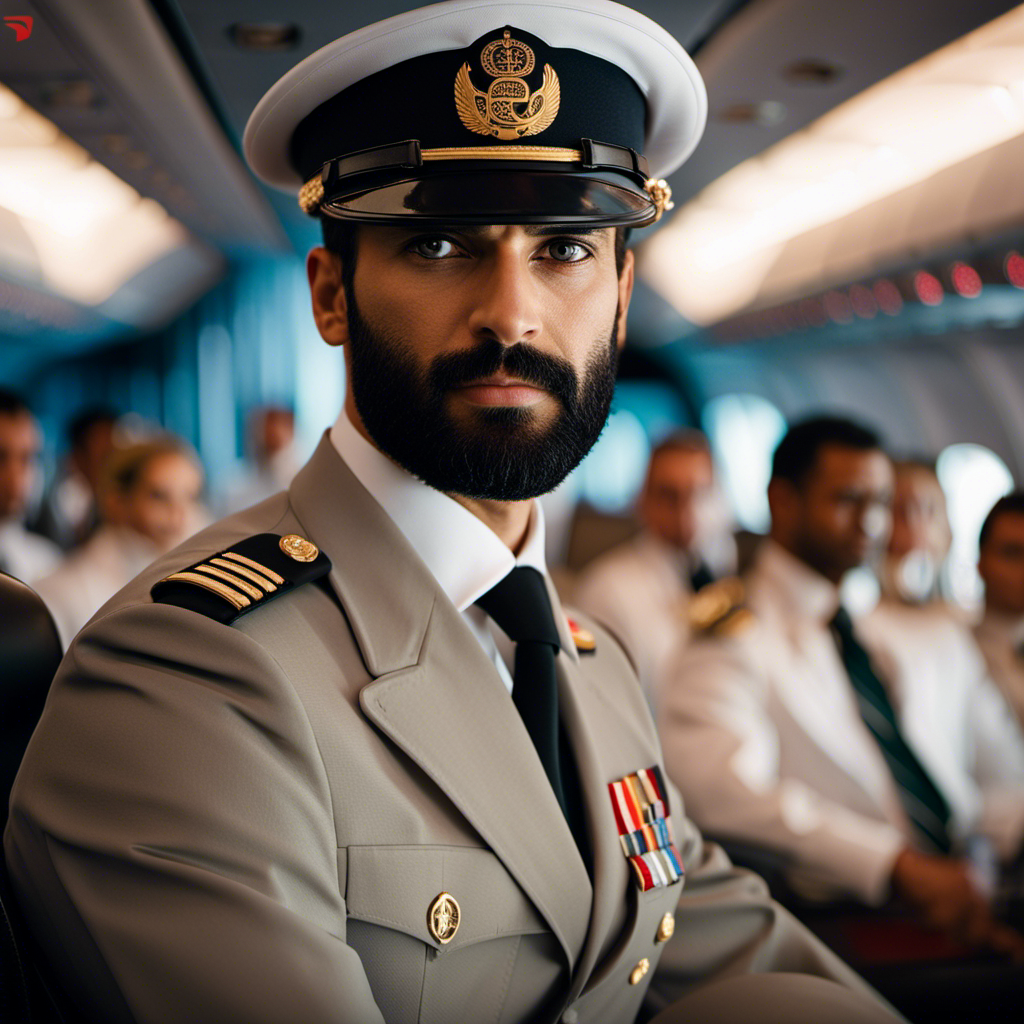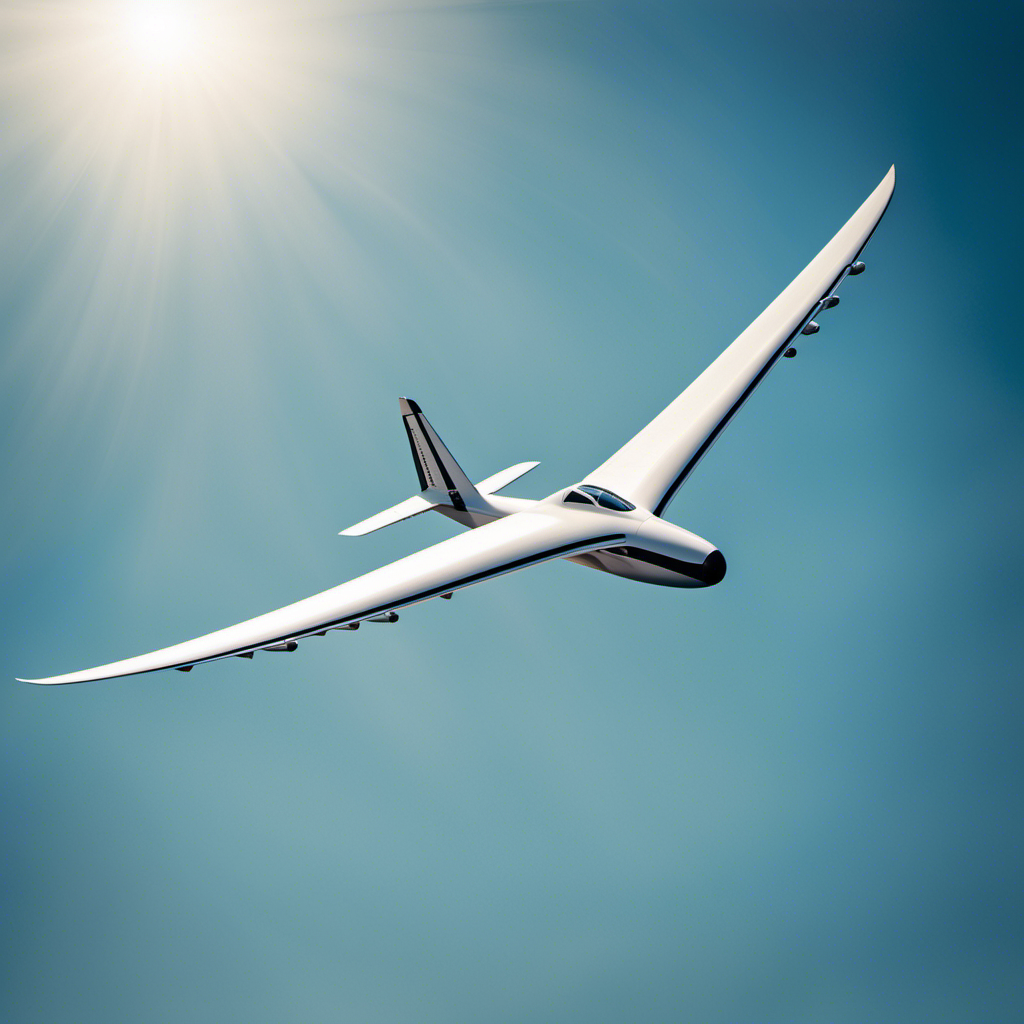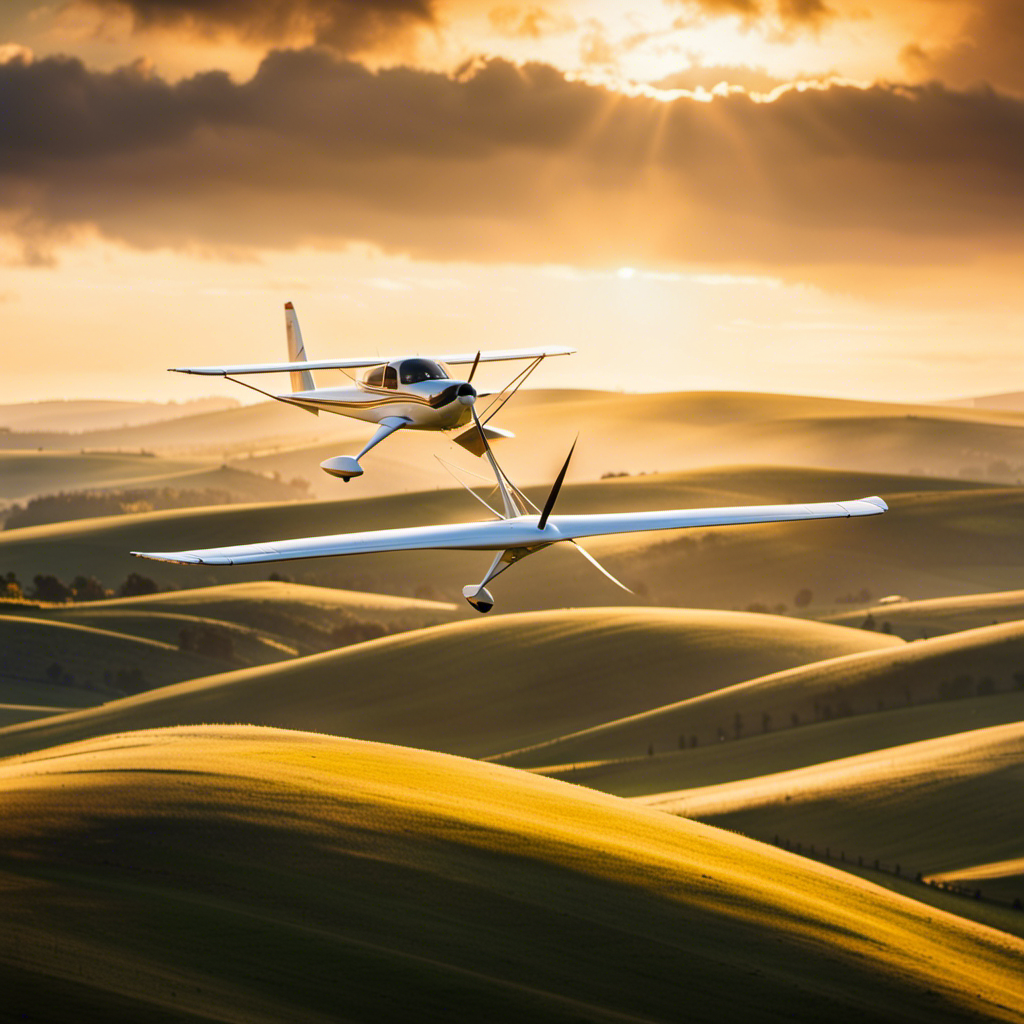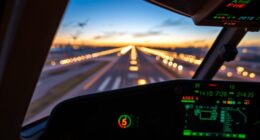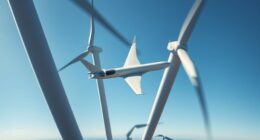When flying a glider, I carefully consider the advantages and disadvantages of wearing a headset while up in the sky.
Did you know that wearing a headset can significantly enhance communication, improve safety, and provide a more immersive flying experience?
In this article, we will explore the various factors to consider when choosing a headset for glider flying, alternative options available, and important regulations to keep in mind.
Join me as we delve into the world of headset usage in gliders and make informed decisions for our flying experiences.
Key Takeaways
- Wearing a headset in a glider enhances communication and improves safety.
- It provides a more immersive flying experience by blocking out ambient noise and offering adjustable microphones for optimal sound quality.
- However, wearing a headset can limit awareness of natural sounds, cause discomfort and fatigue, and reduce the connection with the environment.
- Factors to consider when choosing a headset for glider flying include noise reduction capability, comfort and fit, durability and longevity, impact on communication, and water and dust resistance.
Benefits of Wearing a Headset in a Glider
Wearing a headset in a glider helps you to hear important instructions clearly and reduces the noise from the wind. Headsets designed for gliding have specific features that enhance communication and provide an optimal flying experience.
These headsets typically have noise-canceling technology, which blocks out ambient noise and ensures clear communication between the pilot and passengers. Additionally, they often feature adjustable microphones, allowing for easy positioning and optimal sound quality. The headsets also provide comfort with soft ear cushions and lightweight designs, ensuring long hours of wear without discomfort.
The communication benefits of wearing a headset in a glider are undeniable. They enable effective communication between the pilot and passengers, enhancing safety and coordination during the flight. However, it’s important to be aware of the potential drawbacks of wearing a headset in a glider.
Drawbacks of Wearing a Headset in a Glider
Although there are several drawbacks, using a headset in a glider can be limiting. One of the main disadvantages is the impact it has on communication. While the headset allows for clear and uninterrupted communication with the ground or other pilots, it can also create a barrier between me and the natural sounds of the glider and the environment. This can be quite isolating and detract from the overall flying experience. Additionally, wearing a headset for long periods of time can cause discomfort and fatigue, especially if it is not properly fitted. The table below illustrates some of the drawbacks of using a headset in a glider:
| Drawbacks of Using a Headset in a Glider |
|---|
| Limited awareness of natural sounds |
| Potential discomfort and fatigue |
| Reduced connection with the environment |
| Interference with spatial awareness |
| Difficulty in hearing important cues |
Despite these limitations, a headset is still an important tool for effective communication during glider flying. Now let’s explore the factors to consider in choosing the right headset without compromising the flying experience.
Factors to Consider in Choosing a Headset for Glider Flying
When choosing a headset for glider flying, there are several key factors to consider.
First and foremost is the noise reduction capability of the headset. As a glider pilot, it’s important to have a headset that can effectively block out the noise of the wind and engine, allowing for clear communication with air traffic control and fellow pilots.
Additionally, comfort and fit are crucial in ensuring a pleasant flying experience. The headset should be adjustable and lightweight, providing a secure and comfortable fit for long periods of use.
Noise Reduction Capability
You’ll appreciate the noise reduction capability of a headset in a glider.
When flying a glider, it’s important to have clear communication with the air traffic control and fellow pilots. The passive noise reduction of a headset helps to block out the ambient noise, allowing you to focus on the important radio transmissions.
Additionally, some headsets come with active noise cancellation technology, which actively counteracts the external noise by producing sound waves that cancel out the unwanted noise. This further enhances the clarity of the communication.
In a glider, where the noise from the wind and the environment can be quite significant, having a headset with effective noise reduction capability becomes essential for a seamless and undisturbed flying experience.
Speaking of comfort and fit…
Comfort and Fit
For an optimal flying experience, it’s important to ensure that your headset is comfortable and fits properly. Finding the right size is crucial to avoid discomfort during long flights. A headset that is too tight can cause headaches and pressure points, while a loose-fitting one may not provide sufficient noise reduction.
When choosing a headset, consider the size of your head and the adjustability of the headband. Some headsets come with interchangeable ear cushions to accommodate different head sizes. Additionally, look for features like padding on the headband and ear cups to enhance comfort.
Now that we have covered comfort and fit, let’s move on to the next section: durability and longevity.
Durability and Longevity
To ensure your headset lasts for a long time, it’s important to consider its durability and longevity. When choosing a headset for gliding, there are several key factors to keep in mind:
-
Durability vs. Affordability: Finding a balance between a durable headset and one that fits within your budget is crucial. Investing in a higher-quality headset may be more expensive upfront, but it can save you money in the long run by lasting longer and requiring fewer repairs.
-
Impact on Communication: A durable headset is essential for clear and uninterrupted communication during your gliding adventures. It should be able to withstand the elements and any potential rough handling without compromising the quality of sound transmission.
-
Build Quality: Look for headsets made with robust materials that can withstand the rigors of gliding, such as reinforced cables and sturdy connectors.
-
Water and Dust Resistance: Opt for a headset that is water and dust resistant to protect it from the elements and ensure its longevity.
-
Warranty and Customer Support: Consider the warranty and customer support offered by the manufacturer, as this can provide peace of mind and assistance if any issues arise.
When it comes to headset alternatives for glider pilots, there are a few options to consider.
Headset Alternatives for Glider Pilots
If you want to explore alternatives to wearing a headset in a glider, consider using bone conduction technology. This innovative technology allows sound to be transmitted through the bones of your skull, directly to your inner ear, bypassing the need for traditional headphones or earbuds. One advantage of using bone conduction technology is that it doesn’t obstruct your ears, allowing you to remain aware of your surroundings while still receiving clear audio. Additionally, bone conduction headphones are available in both wireless and wired options, giving you the flexibility to choose what works best for you. In the table below, I have compared the features of headphones vs earbuds and wireless vs wired headsets, to help you make an informed decision:
| Headphones | Earbuds | Wireless Headsets | Wired Headsets | |
|---|---|---|---|---|
| Sound Quality | Good | Good | Good | Good |
| Comfort | High | Moderate | High | High |
| Portability | Low | High | High | Low |
Considering the advantages of bone conduction technology and the features mentioned in the table, it’s worth considering this alternative when choosing a headset for glider piloting. Now, let’s move on to some tips for using a headset in a glider.
Tips for Using a Headset in a Glider
When using a headset in a glider, it is important to adjust the volume accordingly for clear communication. Maintaining your headset is crucial for optimal performance and longevity. Here are some tips to help you make the most of your headset:
- Regularly clean the ear cups and microphone to remove dirt and debris.
- Check the cables for any signs of wear or damage, and replace if necessary.
- Adjust the headband for a comfortable fit, ensuring a secure and stable position.
- Familiarize yourself with the controls and features of your specific headset model.
Taking good care of your headset and adjusting the volume appropriately will enhance your overall flying experience.
Now, let’s delve into personal experiences and recommendations from glider pilots, who have valuable insights to share.
Personal Experiences and Recommendations from Glider Pilots
As a glider pilot, I’ve found that hearing the radio communications clearly is essential for safe and efficient flight operations. Testimonials from pilots who prefer headsets highlight the advantages of improved audio quality and reduced noise interference.
On the other hand, testimonials from pilots who fly without headsets emphasize the benefits of increased situational awareness and comfort.
To strike the right balance between comfort and functionality, it’s crucial to consider factors such as the type of flying, personal preferences, and the specific features of the headset.
Testimonials from Pilots Who Prefer Headsets
Many pilots who prefer headsets have shared their positive testimonials. The main reason why I choose to wear a headset while flying a glider is because of its advanced features and the clarity it provides for communication.
Headsets are designed with noise-canceling technology, allowing me to focus on the important radio communications without any distractions. The microphone boom is adjustable and positioned perfectly to pick up my voice clearly, ensuring that my messages are relayed accurately. The headset also has built-in volume controls and the ability to connect to other devices, such as my smartphone or GPS. These features enhance both the safety and convenience of my flights.
Now, let’s hear from pilots who choose to fly without headsets and their experiences in the next section.
Testimonials from Pilots Who Fly Without Headsets
Imagine the freedom of flying without a headset, relying solely on the sounds of the wind and the engine to guide you through the sky. As a pilot who has flown without a headset in a glider, I can attest to the unique experience it offers.
Here are some reasons why I prefer flying without a headset:
-
Enhanced sensory experience: Without a headset, I can fully immerse myself in the sounds of nature and the aircraft, allowing me to feel more connected to the flying experience.
-
Improved situational awareness: By relying on the natural sounds of the glider, I can better perceive changes in the environment and make more informed decisions during the flight.
-
Increased comfort: Headsets can be bulky and uncomfortable, especially during long flights. Flying without one allows for a more comfortable and unrestricted experience.
-
Greater freedom of movement: Without a headset, I have the freedom to move my head and interact with the cockpit controls without any restrictions.
-
Cost-effective: Glider headset alternatives can be more affordable, making it an attractive option for pilots on a budget.
Finding the right balance between comfort and functionality is crucial when deciding whether to fly with or without a headset. In the next section, we will explore some tips for achieving this balance and making the most out of your flying experience.
Tips for Finding the Right Balance Between Comfort and Functionality
To achieve the right balance between comfort and functionality while flying, consider adjusting the cockpit layout and experimenting with different equipment configurations.
When it comes to headset comfort and sound quality, there are a few key factors to consider. First, ensure that the headset is properly adjusted to fit your head and ears. This will help minimize any discomfort during long flights. Additionally, choose a headset with good sound quality to enhance your communication experience in the cockpit.
Look for headsets that offer noise-cancelling technology to reduce background noise and improve clarity. It’s also important to regularly maintain and clean your headset to ensure optimal performance. By prioritizing both comfort and sound quality, you can enhance your overall flying experience.
Now, let’s delve into the regulations and guidelines for headset usage in gliders.
Regulations and Guidelines for Headset Usage in Gliders
There are no specific regulations or guidelines regarding the usage of headsets in gliders. However, using a headset in gliders offers several benefits. It helps to block out wind and engine noise, improving communication between the pilot and passengers. It also provides clear and uninterrupted audio, crucial for receiving important instructions during the flight. Maintenance involves regularly cleaning the headset with a soft cloth and mild cleaning solution, as well as storing it in a protective case. The future of headset technology in glider flying looks promising, with advancements in noise cancellation and wireless connectivity on the horizon. As technology improves, we can expect even better performance and functionality in glider headsets.
The Future of Headset Technology in Glider Flying
Looking ahead, advances in headset technology for glider flying will bring exciting possibilities such as improved noise cancellation and wireless connectivity. These advancements will have a significant impact on pilot performance, enhancing their ability to communicate effectively and focus on flying.
Here are some key areas where headset technology advancements will make a difference:
-
Enhanced noise cancellation: Advanced noise cancellation algorithms will filter out unwanted cockpit noise, allowing pilots to hear important radio transmissions and warnings more clearly.
-
Wireless connectivity: Wireless headsets will eliminate the inconvenience of tangled cords, providing pilots with more freedom of movement in the cockpit.
-
Integrated communication systems: Headsets with integrated communication systems will allow pilots to seamlessly switch between radio frequencies and communicate with other gliders or ground control.
-
Voice recognition technology: With voice recognition technology, pilots can control various functions of their glider or headset hands-free, reducing distractions and improving safety.
These advancements in headset technology will revolutionize glider flying, enhancing pilot performance and safety.
As we look towards the future, it is crucial to consider the importance of training and education on headset usage in gliders.
Training and Education on Headset Usage in Gliders
When it comes to training and education, it’s important to familiarize yourself with proper usage of the headset in a glider. Maintaining your headset is crucial to ensure communication clarity while flying.
Proper headset maintenance includes regular cleaning of the ear cups and microphone, as well as checking for any loose connections or damaged wires. It’s also essential to store the headset in a protective case when not in use to prevent any potential damage.
Clear communication is vital in glider flying, as it allows for effective communication with air traffic control and other pilots. A well-maintained headset will help minimize any interference or static during communication, ensuring that important instructions are received and understood clearly.
With proper training and knowledge of headset usage, you can enhance your glider flying experience by making informed decisions that prioritize communication clarity and safety.
Conclusion: Making an Informed Decision for Your Glider Flying Experience
To make an informed decision for your glider flying experience, consider the importance of proper training and knowledge on headset usage.
Wearing a headset not only enhances communication during your flight but also ensures safety and a more enjoyable experience.
When it comes to headset maintenance, regular cleaning and inspection are crucial. Dust, dirt, and debris can affect the performance and lifespan of your headset.
Additionally, understanding the impact on communication is vital. Clear and uninterrupted communication with the ground and other pilots is essential for safe and efficient glider operations.
Properly functioning headsets can eliminate background noise and provide crystal-clear sound, allowing for effective communication and coordination.
Frequently Asked Questions
Are there any health risks associated with wearing a headset for extended periods of time in a glider?
Wearing a headset for extended periods in a glider has potential health benefits, such as protecting hearing and enabling clear communication. However, long-term effects may include discomfort and pressure sores, requiring regular breaks and proper fitting equipment.
Can wearing a headset in a glider affect the pilot’s ability to hear important environmental sounds?
Wearing a headset in a glider can impede the pilot’s ability to hear important environmental sounds. The effects of noise cancellation can limit auditory awareness, but alternative communication methods can mitigate this issue.
Is it necessary to wear a headset in a glider, or can I rely on the glider’s built-in communication system?
In a glider, wearing a headset is not necessary as glider communication systems provide an alternative. These systems enable effective communication without compromising the pilot’s ability to hear important environmental sounds.
How do I know which type of headset is compatible with my glider’s communication system?
To determine headset compatibility with a glider’s communication system, consult the glider’s specifications or manual for recommended headset models. Additionally, purchasing options can be found at aviation supply stores or online retailers specializing in aircraft accessories.
Are there any specific safety guidelines or regulations regarding the use of headsets in gliders?
When it comes to headset use in gliders, it’s crucial to adhere to safety regulations. Understanding headset compatibility with the glider’s communication system is essential to ensure proper functionality and clear communication during flight.
Conclusion
After carefully considering the benefits and drawbacks of wearing a headset in a glider, it’s clear that the decision ultimately rests on personal preference.
While a headset can enhance communication and provide a more immersive flying experience, it may also hinder the feeling of freedom and connection with nature that glider pilots cherish.
Factors such as comfort, noise cancellation, and compatibility should be taken into account when choosing a headset.
Remember, the skies are vast and diverse, so choose wisely and soar to new heights in your glider adventures!
Orion, better known as “Jetstream,” is the voice that brings the stories of the skies to life. His fascination with aviation began at a young age, sparked by his father’s tales of flying and adventure. Orion’s journey into the world of gliding was serendipitous, and from the moment he took his first glider flight, he knew he had found his calling.
